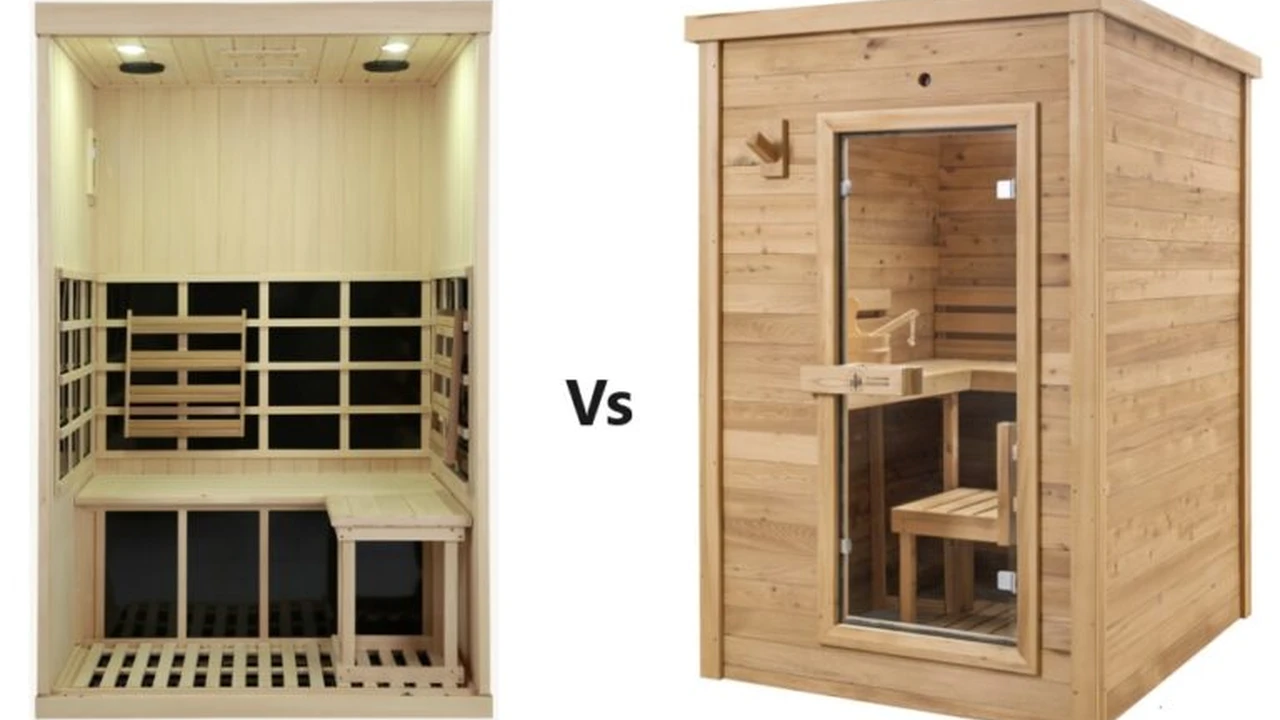Comparing Infrared Saunas and Traditional Saunas
Understand the differences between infrared saunas and traditional saunas. Choose the best option for detoxification and relaxation.

Understand the differences between infrared saunas and traditional saunas. Choose the best option for detoxification and relaxation.
Comparing Infrared Saunas and Traditional Saunas
Infrared Sauna vs Traditional Sauna Understanding the Core Differences
Alright, let's dive into the steamy world of saunas! You've probably heard about saunas being great for relaxation, detoxification, and even muscle recovery. But did you know there are fundamentally different types? We're talking about traditional saunas and infrared saunas. While both aim to make you sweat and feel good, they go about it in completely different ways. Think of it like this: a traditional sauna is like baking a cake in a conventional oven, heating the air around it. An infrared sauna is more like a toaster oven, directly heating the cake itself with radiant energy. This core difference in how they generate heat leads to a whole host of variations in experience, benefits, and even how you should use them.
Traditional saunas, often called Finnish saunas, use a heater (electric or wood-burning) to warm up rocks, which then radiate heat into the air. You often pour water over these rocks to create steam, increasing the humidity. This results in a very hot, humid environment, typically ranging from 180°F to 200°F (82°C to 93°C). The heat is intense and envelops your entire body. It's a classic experience, often associated with deep relaxation and a feeling of cleansing.
Infrared saunas, on the other hand, use infrared heaters to emit electromagnetic radiation that directly heats your body, rather than the air around you. This means the air temperature in an infrared sauna is much lower, usually between 120°F and 150°F (49°C to 66°C). Despite the lower air temperature, you'll still sweat profusely because the infrared waves penetrate your skin, raising your core body temperature. This direct heating mechanism is what many proponents claim offers unique benefits.
Heat Generation and Experience Traditional Sauna Heat vs Infrared Sauna Heat
Let's break down the heat generation and the resulting experience in more detail. In a traditional sauna, the heat is convective and conductive. The hot air heats your skin, and the steam adds to the sensation of intense heat. This can be quite overwhelming for some people, especially those new to saunas. The high humidity can also make breathing feel heavier. However, for many, this intense heat is precisely what they seek for deep muscle relaxation and a feeling of profound detoxification through sweating.
With infrared saunas, the heat is radiant. The infrared waves are absorbed by your body, causing your core temperature to rise. This means you can often tolerate longer sessions in an infrared sauna because the ambient air isn't as scorching. The heat feels more gentle and penetrating. You'll still sweat a lot, but it might feel like a different kind of sweat – often described as a deeper, more detoxifying sweat due to the direct heating of your tissues. This gentler heat can be a big plus for people who find traditional saunas too intense or who have respiratory sensitivities.
Another key difference in experience is the warm-up time. Traditional saunas often take 30-60 minutes to reach their optimal temperature. Infrared saunas typically heat up much faster, often in 10-20 minutes, making them more convenient for quick sessions.
Health Benefits and Detoxification Infrared Sauna Benefits vs Traditional Sauna Benefits
Both types of saunas offer a range of health benefits, many of which overlap. These include improved circulation, muscle relaxation, pain relief, stress reduction, and skin cleansing through sweating. However, some proponents argue that infrared saunas offer unique or enhanced benefits due to their direct heating mechanism.
Traditional Sauna Benefits:
- Cardiovascular Health: The intense heat causes your heart rate to increase, mimicking a light cardiovascular workout.
- Muscle Relaxation and Pain Relief: The heat helps relax muscles and can alleviate joint pain and stiffness.
- Stress Reduction: The warm, quiet environment promotes relaxation and can reduce stress.
- Skin Cleansing: Sweating helps open pores and flush out impurities.
- Improved Circulation: Heat causes blood vessels to dilate, improving blood flow.
Infrared Sauna Benefits:
- Deeper Penetration: Infrared waves penetrate deeper into the body, potentially leading to more profound detoxification at a cellular level.
- Lower Temperature Tolerance: Easier for individuals who find traditional saunas too hot.
- Pain Management: Often cited for effective relief of chronic pain, arthritis, and fibromyalgia due to deeper heat penetration.
- Weight Loss: Some studies suggest infrared saunas can aid in weight loss by increasing core body temperature and metabolism.
- Improved Skin Health: Can stimulate collagen production and improve skin tone.
- Enhanced Detoxification: The direct heating of tissues is believed to release more toxins, including heavy metals, from fat cells.
While both are great for detoxification, the argument for infrared saunas often centers on the idea that the deeper penetration of infrared waves allows for a more efficient release of toxins from fat cells and other tissues, even at lower ambient temperatures. This is a point of ongoing research and debate, but many users report feeling a more profound detox effect from infrared saunas.
Usage Scenarios and Practicality When to Choose Which Sauna Type
Choosing between an infrared and traditional sauna often comes down to your personal preferences, health goals, and practical considerations like space and budget.
Choose a Traditional Sauna if:
- You enjoy intense heat and high humidity.
- You're looking for a classic, social sauna experience (many traditional saunas are larger).
- You want to pour water over rocks to create steam (loyly).
- You prioritize muscle relaxation and general stress relief.
- You have access to a public traditional sauna or have ample space for a larger home unit.
Choose an Infrared Sauna if:
- You prefer a gentler heat that's easier to tolerate for longer sessions.
- You're specifically targeting deeper detoxification or chronic pain relief.
- You have respiratory issues that make high humidity uncomfortable.
- You have limited space at home, as infrared saunas tend to be more compact.
- You want faster warm-up times for quick, convenient sessions.
- You're sensitive to very high temperatures.
For home use, infrared saunas have become increasingly popular due to their smaller footprint, lower energy consumption, and easier installation. Traditional saunas, especially those with wood-burning heaters, often require more complex ventilation and space considerations.
Product Recommendations and Comparisons Top Infrared and Traditional Sauna Brands
Okay, let's get to some actual product recommendations. The market for home saunas has exploded, offering a wide range of options for different budgets and needs. Remember, prices can fluctuate, so always check current listings.
Infrared Sauna Recommendations:
When looking at infrared saunas, consider the type of infrared (far, mid, near), the material (cedar is popular), EMF levels (lower is generally better), and the number of heaters.
1. Clearlight Sanctuary Full Spectrum Infrared Sauna
- Type: Full Spectrum (Near, Mid, Far Infrared)
- Features: Low EMF, medical-grade chromotherapy lighting, ergonomic backrest, smartphone control. Made with eco-certified Western Red Cedar or Basswood.
- Use Case: Ideal for those seeking comprehensive benefits, including skin rejuvenation (near IR), pain relief (mid IR), and deep detoxification (far IR). Great for daily use due to low EMF.
- Comparison: Often considered a premium brand, known for its high-quality construction, low EMF technology, and full-spectrum capabilities. It's a significant investment but offers top-tier performance and safety.
- Estimated Price Range: $5,000 - $10,000+ depending on size (1-person to 5-person models).
2. Sunlighten mPulse Series Infrared Sauna
- Type: Full Spectrum (Near, Mid, Far Infrared)
- Features: Patented Solocarbon 3-in-1 heaters, Android-powered control panel with pre-set programs for different health goals (cardio, detox, pain relief, etc.), low EMF.
- Use Case: Excellent for users who want a highly customizable experience with specific health programs. The pre-set options make it user-friendly for beginners.
- Comparison: Sunlighten is another leading brand, often competing directly with Clearlight. Their mPulse series is renowned for its advanced technology and program versatility. They also emphasize low EMF.
- Estimated Price Range: $4,500 - $9,000+ depending on size.
3. Dynamic Saunas Barcelona Edition Far Infrared Sauna
- Type: Far Infrared
- Features: Canadian Hemlock wood, low EMF carbon heaters, chromotherapy, MP3 auxiliary connection. More budget-friendly.
- Use Case: A great entry-level option for those new to infrared saunas or with a tighter budget. Focuses primarily on far infrared benefits like detoxification and relaxation.
- Comparison: Dynamic Saunas offer good value for money. While they might not have all the advanced features of Clearlight or Sunlighten, they provide a solid far infrared experience at a more accessible price point.
- Estimated Price Range: $1,500 - $3,000 depending on size (1-person to 3-person models).
4. HigherDOSE Infrared Sauna Blanket
- Type: Far Infrared (portable)
- Features: Portable, easy to store, uses far infrared heat, charcoal and clay layers for added benefits.
- Use Case: Perfect for those with very limited space, renters, or individuals who want a more affordable and flexible infrared experience. Great for travel.
- Comparison: This isn't a traditional sauna cabin, but a popular alternative for getting infrared benefits. It's significantly cheaper and more convenient than a full sauna, though the experience is different (you're lying down, wrapped in a blanket).
- Estimated Price: $500 - $700.
Traditional Sauna Recommendations:
For traditional saunas, consider the heater type (electric, wood-burning), wood type (cedar, spruce), size, and whether it's an indoor or outdoor model.
1. Almost Heaven Saunas (Various Models like Allegheny, Pinnacle)
- Type: Traditional (Electric or Wood-Burning options)
- Features: Handcrafted in the USA, high-quality Western Red Cedar or Hemlock, various sizes and designs (barrel, indoor cabin). Includes heater and stones.
- Use Case: Excellent for those seeking an authentic, high-quality traditional sauna experience. Their barrel saunas are popular for outdoor use, while their indoor cabins fit well in basements or dedicated wellness rooms.
- Comparison: Almost Heaven is a well-respected brand known for its craftsmanship and durability. They offer a wide range of models to suit different aesthetic preferences and space requirements.
- Estimated Price Range: $3,000 - $8,000+ depending on size and features.
2. Finlandia Sauna (FLB Series)
- Type: Traditional (Electric)
- Features: Made in the USA, high-quality clear Western Red Cedar, stainless steel heaters, various sizes for home use.
- Use Case: Ideal for those who want a classic, reliable indoor traditional sauna. Known for their robust heaters and durable construction.
- Comparison: Finlandia is a long-standing brand with a reputation for producing high-performance traditional saunas. They focus on quality materials and effective heating.
- Estimated Price Range: $4,000 - $9,000+ depending on size.
3. Dundalk LeisureCraft Canadian Timber Collection
- Type: Traditional (Electric or Wood-Burning)
- Features: Made from Canadian Eastern White Cedar, various barrel and cabin designs, often come as DIY kits for assembly.
- Use Case: Great for those who enjoy a DIY project and want a rustic, natural aesthetic, especially for outdoor installations.
- Comparison: Dundalk offers beautiful, high-quality saunas, often with a focus on outdoor barrel designs. They provide a more hands-on assembly experience but result in a very sturdy and authentic sauna.
- Estimated Price Range: $3,500 - $7,000+ depending on size and heater type.
4. SereneLife Portable Infrared Home Spa
- Type: Traditional (Portable Steam Sauna)
- Features: Foldable, includes a steam generator, remote control, and chair.
- Use Case: A very budget-friendly and space-saving option for those who want a quick steam sauna experience without a full cabin.
- Comparison: This is a portable steam sauna, not a dry traditional sauna. It's a good alternative for those who want the benefits of heat and steam on a very limited budget and space. The experience is less immersive than a full cabin.
- Estimated Price: $150 - $300.
Installation and Maintenance Considerations Setting Up Your Sauna
Before you pull the trigger on a sauna purchase, it's super important to think about installation and ongoing maintenance. This isn't just about buying the unit; it's about getting it set up correctly and keeping it running smoothly.
Infrared Sauna Installation:
Infrared saunas are generally easier to install than traditional ones. Most come as pre-fabricated panels that you assemble. You'll typically need:
- Dedicated Electrical Outlet: Many infrared saunas, especially larger ones, require a dedicated 20-amp or 30-amp 120V or 240V circuit. Always check the manufacturer's specifications. This might mean hiring an electrician.
- Level Surface: A flat, stable floor is crucial.
- Ventilation: While they don't produce steam, good air circulation in the room where the sauna is placed is still recommended to prevent moisture buildup from sweat.
- Assembly: Most can be assembled by two people in a few hours with basic tools.
Traditional Sauna Installation:
Traditional saunas, especially larger or custom-built ones, can be more complex:
- Electrical Requirements: Electric heaters for traditional saunas often require a dedicated 240V circuit, and sometimes higher amperage, depending on the heater size. Professional electrical installation is almost always necessary.
- Ventilation: Proper ventilation is critical for safety and comfort. This involves intake and exhaust vents to ensure fresh air circulation and prevent overheating.
- Waterproofing: If you plan to pour water over stones, the floor and walls around the heater should be water-resistant.
- Drainage: While not always strictly necessary for home saunas, some prefer a floor drain for easier cleaning.
- Space: Traditional saunas, especially barrel saunas, can take up significant space.
- Wood-Burning Saunas: These are the most complex, requiring a chimney, fire-resistant materials, and adherence to strict building codes. Professional installation is highly recommended.
Maintenance for Both Types:
- Cleaning: Wipe down benches and walls after each use to remove sweat. A mild, non-toxic cleaner can be used periodically. Avoid harsh chemicals.
- Wood Care: Wood can absorb sweat and oils. Sanding benches lightly every few years can help keep them fresh. Avoid sealing the wood inside the sauna, as it needs to breathe.
- Heater Maintenance: For traditional saunas, check the stones periodically and replace any that are cracked or crumbling. For infrared saunas, ensure the emitters are clean and unobstructed.
- Ventilation: Keep vents clear and ensure good airflow in the room where the sauna is located.
- Humidity Control: For traditional saunas, manage the amount of water you pour on the stones to control humidity.
Always refer to the manufacturer's specific instructions for installation and maintenance, as these can vary significantly between models and brands.
Safety Guidelines and Best Practices Maximizing Your Sauna Experience
Saunas are generally safe, but like any heat therapy, there are important safety guidelines and best practices to follow to maximize your experience and avoid any issues.
General Sauna Safety Tips:
- Stay Hydrated: Drink plenty of water before, during (if needed), and after your sauna session. You'll sweat a lot, so replenishing fluids is crucial. Electrolyte-rich drinks can also be beneficial.
- Listen to Your Body: Don't push yourself. If you feel dizzy, nauseous, or unwell, exit the sauna immediately.
- Limit Session Time: Start with shorter sessions (10-15 minutes) and gradually increase as your body adapts. Most sessions range from 15-45 minutes.
- Avoid Alcohol and Drugs: Never use a sauna under the influence of alcohol or recreational drugs, as this can impair your judgment and increase health risks.
- Cool Down Gradually: After your session, cool down slowly. A lukewarm shower is often recommended before a cold one.
- Supervise Children: Children should always be supervised in a sauna and their sessions should be much shorter and at lower temperatures.
- Avoid Eating Heavy Meals: It's best to avoid heavy meals right before a sauna session. A light snack is fine.
Specific Considerations:
- Medical Conditions: If you have any pre-existing medical conditions (e.g., heart disease, high or low blood pressure, diabetes), are pregnant, or are taking medications, consult your doctor before using a sauna.
- Jewelry and Metal: Remove any metal jewelry or accessories before entering, as they can heat up and cause burns.
- Clothing: Wear minimal clothing, or none at all, to allow your skin to breathe and sweat freely. A towel to sit on is always a good idea for hygiene.
- EMF Exposure (Infrared Saunas): While many modern infrared saunas are designed to have low EMF, if you're particularly sensitive or concerned, look for models that specifically advertise ultra-low EMF.
- Heater Safety (Traditional Saunas): Be mindful of the hot heater and stones. Keep a safe distance and never touch them directly.
By following these guidelines, you can ensure a safe, enjoyable, and beneficial sauna experience, whether you choose the intense heat of a traditional sauna or the penetrating warmth of an infrared one.
:max_bytes(150000):strip_icc()/277019-baked-pork-chops-with-cream-of-mushroom-soup-DDMFS-beauty-4x3-BG-7505-5762b731cf30447d9cbbbbbf387beafa.jpg)






